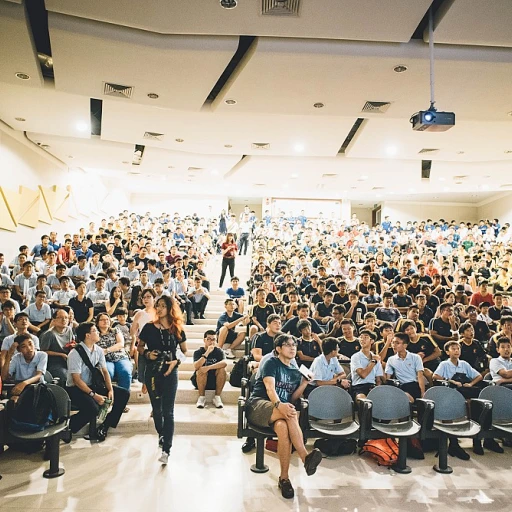Understanding the Importance of Adaptability in the Workplace
Building a Resilient Workforce Through Adaptability
In today’s fast-paced workplace, adaptability is not merely a desirable trait; it's an essential skill. The ability to adjust to change quickly and efficiently can distinguish thriving organizations from those that fall behind. Training employees to enhance their adaptability is a critical component in sustaining a resilient workforce.
Adaptability doesn’t just improve the individual's resilience, but it also fortifies the entire team. In the midst of technological advancements and evolving market demands, an adaptable mindset can significantly shape problem-solving and decision-making processes. Investing in skills training encourages flexibility and instills a growth mindset, allowing employees to navigate challenges with ease.
Workplace adaptability training often involves structured courses designed to fine-tune personal skills. These courses improve flexibility by focusing on emotional intelligence and emotional resilience. They're crafted to foster an environment where continuous learning is part of everyday work life. By cultivating these skills, employees not only become better equipped to handle abrupt changes but also contribute to a culture of innovation and proactive learning.
Integrating adaptability skills into an action plan will help prepare employees for ongoing changes. Such training programs aim to build a workforce that can tackle the unexpected confidently and effectively, making adaptability an intrinsic part of everyday work.
Moreover, the transformation brought by flexibility training can lead to substantial productivity gains. As employees learn to handle stress and uncertainty, they do not just withstand workplace challenges but thrive in them, driving the organization's success forward. It’s crucial for management to recognize this and invest time and resources to enhance adaptability flexibility within their teams.
While offering training courses is a step in the right direction, ensuring that these initiatives align with personal growth goals amplifies their impact. Thoughtful implementation creates a ripple effect that boosts resilience across the workforce, fostering an environment where adaptability becomes second nature.
Ultimately, these efforts lead to not just individual growth but heightened team dynamics. Organizations that prioritize adaptability training can expect a workforce ready to embrace change and generate innovative solutions. As a starting point, recognizing the importance of adaptability can inform effective
employee engagement strategies, setting the stage for a driven, dynamic workplace.
Key Components of Effective Adaptability Training
Crafting a Comprehensive Approach to Skill Enhancement
Organizations today prioritize adaptability as a key competency in the workplace. A successful training program focuses on enhancing a set of core skills that encourage adaptability, resilience, and flexibility. Here are some critical components that can help in developing an effective training program:
- Building a Growth Mindset: Encourage a learning culture where employees are driven by curiosity and a desire to learn more. A growth mindset supports the idea that adaptability can be enhanced by consistently acquiring new skills.
- Emotional Intelligence and Resilience: Emotional intelligence is crucial for adaptability. Training employees to manage their emotions and respond constructively to workplace changes can improve their emotional resilience and adaptability skills.
- Problem Solving and Decision Making: Courses that focus on strengthening these capabilities help in adapting to new situations efficiently. By building strong problem-solving techniques, employees can meet challenges head-on.
- Fostering Change Management Mindset: Adaptability necessitates a readiness for change and strategic action plans. Providing skills training that familiarizes employees with change management principles reinforces flexibility.
The integration of these elements into adaptability training programs ensures a more tailored development experience. To dive deeper into enhancing employee skills in the workplace, explore this comprehensive guide on
structured workplace learning.
Leveraging Data to Tailor Training Programs
Adapting Training Programs Using Workforce Data
To effectively tailor training programs that enhance adaptability and resilience in the workplace, leveraging data is of paramount importance. Once the need for adaptability in the workplace is recognized, focusing on actionable insights from relevant data can significantly drive the efficacy of these programs.
Organizations can harness a variety of data sources to customize training modules:
- Skills Gap Analysis: By identifying existing skill levels within the workforce, businesses can pinpoint specific areas where training is needed. This helps in shaping courses that will enhance flexibility and problem-solving capabilities.
- Performance Metrics: Analyzing performance data not only highlights areas needing improvement but also identifies employees who have previously demonstrated emotional resilience and a growth mindset. These insights will help tailor adaptability courses to empower the entire workforce.
- Learning Preferences: Gathering data on employee learning preferences can optimize the delivery methods of training programs, ensuring that courses are engaging and suited to diverse learning styles, thereby improving workplace adaptability skills.
Equipped with these insights, businesses can develop training courses that are not only relevant but also resonate with personal and professional growth objectives of employees. This approach essentially creates a curated learning environment that explicitly focuses on enhancing both emotional intelligence and decision-making skills.
Moreover, an action plan informed by data enables management to implement training courses that build adaptability flexibility systematically, resulting in a marked improvement in workplace skills. This form of flexibility training fosters a culture of continuous learning and change readiness.
As businesses navigate an ever-evolving corporate landscape, the integration of data-driven insights into training programs ensures that employees not only cope with change but thrive in it. For further insights into how organizations can recruit top talent in evolving fields, explore this
detailed guide on recruiting roles in AI companies.
Measuring the Impact of Adaptability Training
Evaluating Training Effectiveness and Outcomes
Evaluating the effectiveness and outcomes of adaptability training is crucial to ensure the return on investment and positive impact on the team. One of the key areas to focus on is measuring improvements in the adaptability skills of employees. This can be accomplished through a combination of qualitative and quantitative methods.
- Feedback Mechanisms: Gathering feedback from employees who have completed the training courses can provide valuable insights into the perceived effectiveness and any areas needing improvement. Facilitating open forums or feedback sessions can allow employees to share their thoughts on the training’s impact on their ability to handle change in the workplace.
- Performance Metrics: Analyzing performance indicators such as increased productivity, improved problem-solving skills, and enhanced decision-making ability can offer quantifiable data on the success of adaptability training. Monitoring these metrics over time will help in comparing pre-training and post-training performance.
- Retention and Resilience: Assessing the retention of skills and resilience in challenging situations is another way to gauge training effectiveness. Employees who build adaptability resilience tend to show greater emotional intelligence and flexibility in managing unexpected changes or stresses, thus improving personal and professional growth.
- Continuous Learning Assessments: Implementing regular assessments or short refresher courses can help in ensuring that the skills learned during the initial training are sustained over time. Creating an adaptable learning mindset among employees promotes ongoing development and readiness to face new challenges.
Measuring the impact of adaptability training paves the way for continuous improvement and fine-tuning. As organizations increasingly face change, the ability to improve adaptability becomes essential, and a structured approach to measuring training outcomes will help inform decisions for future training modifications and enhancements.
Challenges in Implementing Adaptability Training
Overcoming Obstacles in Implementing Adaptability Training
Implementing adaptability and flexibility training programs in the workplace comes with its own set of challenges. Understanding these obstacles is vital to successfully integrate these initiatives and foster a resilient workforce equipped with adaptability skills.
- Resistance to Change: Employees may exhibit resistance when introduced to new adaptability training courses. The key lies in fostering an adaptability mindset that encourages learning and growth. Highlighting the personal and professional gains from such courses can incentivize participation and engagement.
- Limited Resources: Providing comprehensive training often requires considerable resources, which not all organizations can easily allocate. Ensuring management buys into the adaptability training can help unlock necessary funding and support. In many cases, flexibility training can be tailored to fit the available resources, making it feasible to implement without undue strain.
- Measurable Outcomes: Quantifying the impact of training courses focused on adaptability resiliency remains a significant challenge. Developing clear metrics and utilizing data analytics to assess improvements in problem-solving, decision-making, and emotional resilience can help illustrate the tangible benefits of these programs.
- Cultural Alignment: Successfully embedding a culture of adaptability requires more than just skills training—it necessitates an organizational shift. Encouraging a growth mindset supported by leadership can enable the integration of adaptability concepts into the daily working environment.
Addressing these challenges with well-structured action plans can improve adaptability across the organization. Workplace adaptability is not about one-off courses but building resilience and emotional intelligence over time, resulting in a more dynamic and versatile workforce. Companies that prioritize adaptability in their training programs will help employees thrive in an ever-changing work environment.
Future Trends in Adaptability Training
Looking Ahead: Trends Shaping the Future of Adaptability Training
As workplaces continue to evolve, the need to enhance adaptability remains a priority. Several trends are emerging that influence how adaptability training will be conducted in the future.
Firstly, there is an increasing focus on personalized learning experiences. Unlike traditional training courses, personalized approaches allow employees to engage with content at their pace and according to specific needs. This level of customization enhances the learning experience and leads to better retention and application of skills.
Additionally, the incorporation of technology in training programs is reshaping adaptability strategies. Virtual reality and augmented reality are becoming tools for immersive learning, offering a safe environment to build adaptability skills. These technologies enable employees to simulate real-world scenarios, which significantly aids in developing problem-solving and decision-making capabilities.
The rise of data-driven insights has opened avenues for tailoring training content even further. Metrics and analytics help in understanding which aspects of adaptability training contribute most effectively to skill enhancement. This data allows management to make informed decisions, ensuring that training remains relevant and impactful.
Furthermore, the integration of emotional intelligence in adaptability training is gaining prominence. Training programs now pay closer attention to emotional resilience, guiding employees on how to remain calm and proactive during changes or challenges in the workplace. Embracing emotional intelligence helps in building resilience and flexibility, essential qualities for thriving in dynamic work environments.
Lastly, the concept of a growth mindset permeates modern training courses. The belief in continuous learning and development as an action plan for improvement is a mindset that organizations strive to foster. This encourages employees to view challenges as opportunities, building their adaptability skills over time.
In summary, as adaptability training continues to evolve, organizations must adjust their strategies to leverage these trends. Tailoring training efforts to foster emotional intelligence and resilience will help employees navigate the ever-changing workplace landscape effectively.













